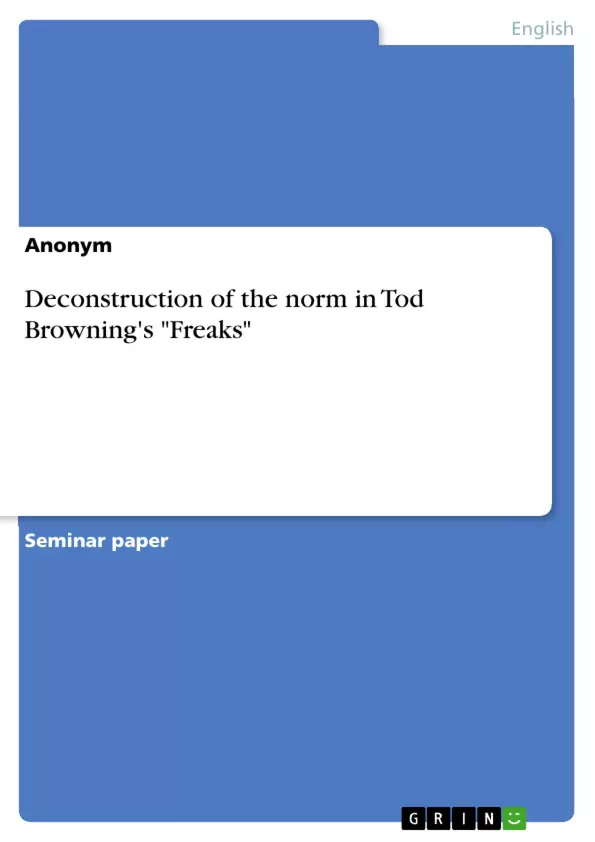This paper is about Tod Browning’s controversial movie "Freaks". It serves to explain how the movie "Freaks", deconstructs what is understood as the category of “normal” people. What leads the viewer to judge the “normals” as such in the beginning of the movie is going to be examined throughout this work.
This paper illustrates what is understood as “monsters” and what the function of this constructed borderline between “normals” and “freaks” is. Therefore it is looked at the meaning of deformity in history. It is going to be analyzed how the viewer is introduced into the movie by the preface.
At the film’s turning point (wedding banquet), what is firstly presented to the viewer as “freak” suddenly is understood as “normal”. How this deconstruction of the “freak” proceeds is going to be described in the following.
In the movie, terms for referring to disabled people play an important role in determining how the viewer perceives the characters that are presented. Already the movie title Freaks is very provocative for it is the term describing a failed product of procreation. Throughout this paper the term “freaks” is going to be used. No other terms like “disabled” or “handicapped” appeared more reasonable as the term “freak” for it expresses best how the assumed category of the “freak” is a construct and dependent on the condition of a relation, in addition it is connected to perspectives. From an anthropological perspective it is always recommended, in case of doubt, to call a group by its self-imposed name. Moreover the term “freak” refers to the relation of a person whose deviation from the norm is used for the entertainment of others and the person who is entertained. This describes best that this category is a construct and underlines that to be a “freak” is not primarily a body condition but rather a social relation.
Inhaltsverzeichnis (Table of Contents)
- Introduction
- Context
- Negative Associations
- Freak's preface
- The monster in history.
- Deconstruction and conceptualization
- Terms and conceptualization of "monster/ freak" and "normal"
- Deconstruction of the norm
- Tools helping the deconstruction ..
- Names
- The camera
- Deconstruction by pictures.
- Exploitation.
- Conclusion......
Zielsetzung und Themenschwerpunkte (Objectives and Key Themes)
This paper analyzes Tod Browning's controversial film "Freaks" and aims to explain how the film deconstructs the concept of "normal" individuals. It delves into the viewer's perception of "normals" at the film's beginning, and examines how this perception is challenged throughout the work.
- The film's deconstruction of the "normal" category.
- The role of deformity in history and its impact on the viewer's perception.
- The function of the constructed borderline between "normals" and "freaks."
- The significance of names and the camera in deconstructing the norm.
- The exploration of whether "Freaks" is an exploitative movie or not.
Zusammenfassung der Kapitel (Chapter Summaries)
- Introduction: This chapter introduces the main topic of the paper, focusing on Tod Browning's film "Freaks" and its deconstruction of the "normal" category. It also explores the film's portrayal of "monsters" and the constructed borderline between "normals" and "freaks."
- Context: This chapter provides a historical and cultural context for the film, highlighting the use of "real life freaks" in the cast and the controversial reception of the film. It also explores the film's adaptation from a short story and the controversies surrounding its release.
- Negative Associations: This chapter examines the negative associations with "freaks" as portrayed in the film. It focuses on the film's preface, which aims to warn the viewer about the content of the movie, and the historical context of how shocking the film was for its time. The chapter explores how the film aims to deconstruct these negative associations.
Schlüsselwörter (Keywords)
The key terms and concepts explored in this paper include: deconstruction of the norm, "monster"/"freak", "normal", deformity, historical context, film analysis, Tod Browning, "Freaks", exploitation, camera, names, and visual representation.
- Citation du texte
- Anonym (Auteur), 2014, Deconstruction of the norm in Tod Browning's "Freaks", Munich, GRIN Verlag, https://www.grin.com/document/319093



